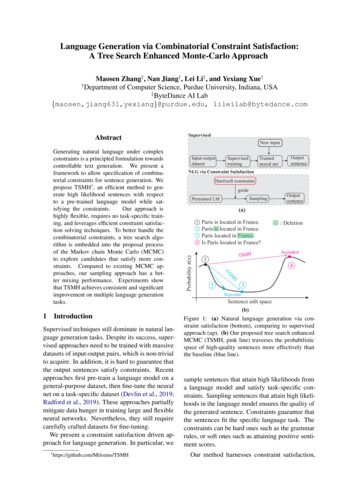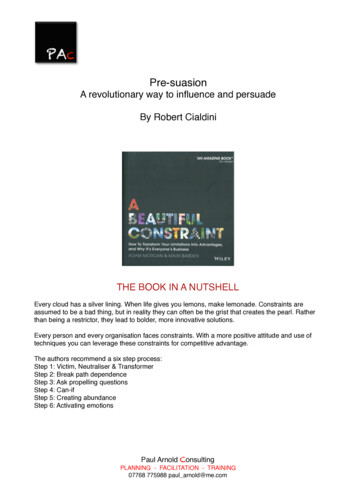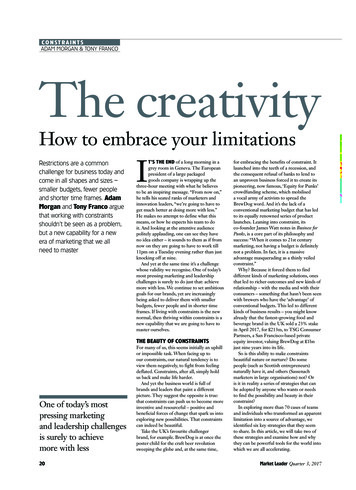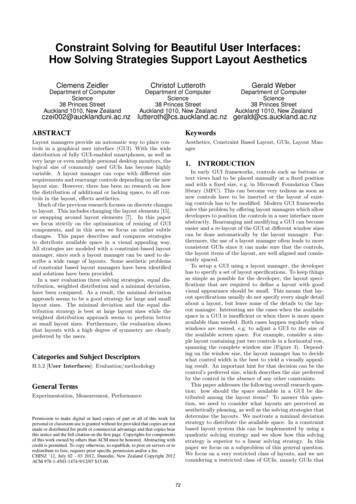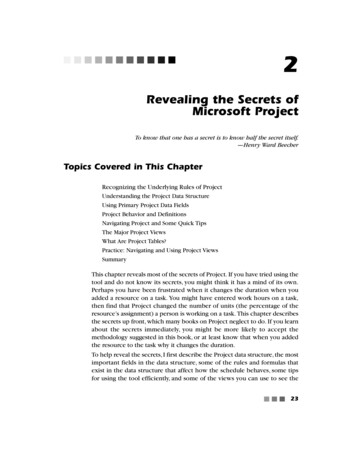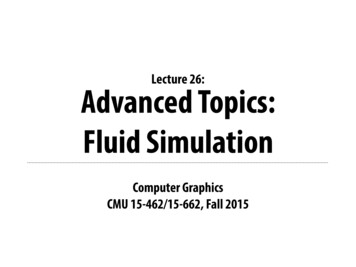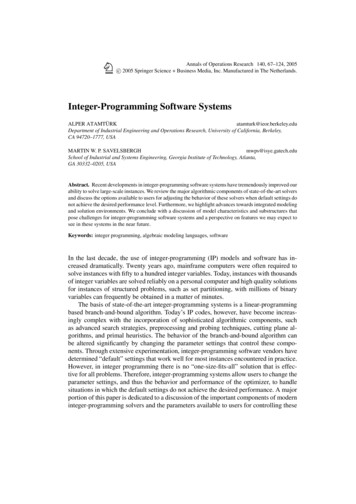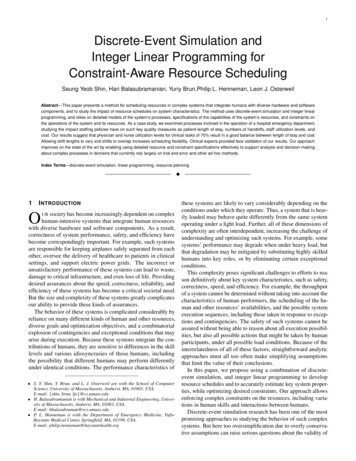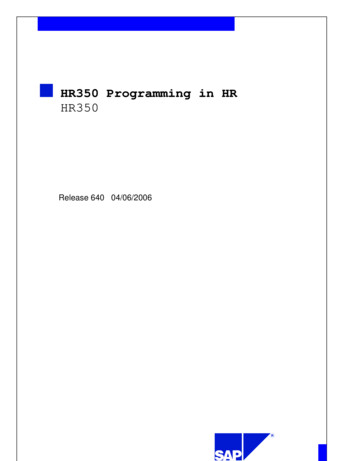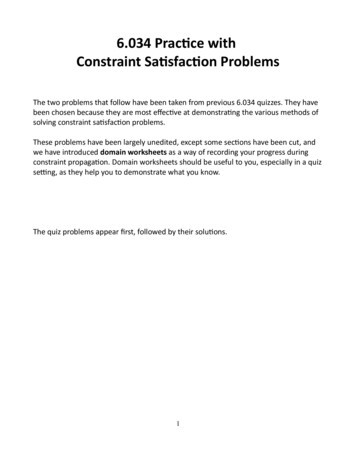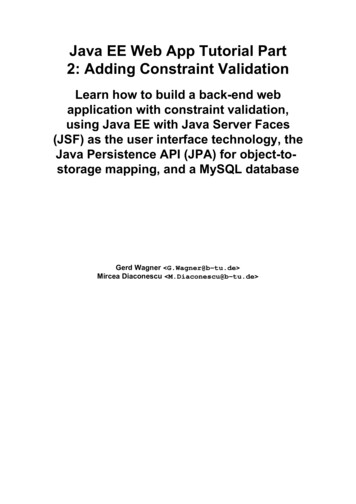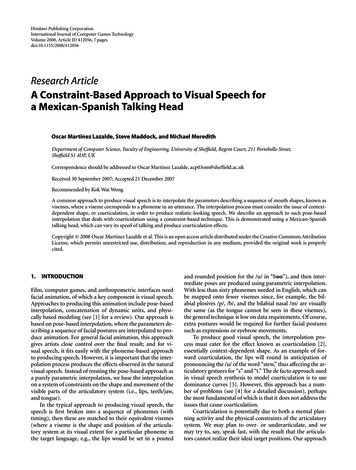
Transcription
Hindawi Publishing CorporationInternational Journal of Computer Games TechnologyVolume 2008, Article ID 412056, 7 pagesdoi:10.1155/2008/412056Research ArticleA Constraint-Based Approach to Visual Speech fora Mexican-Spanish Talking HeadOscar Martinez Lazalde, Steve Maddock, and Michael MeredithDepartment of Computer Science, Faculty of Engineering, University of Sheffield, Regent Court, 211 Portobello Street,Sheffield S1 4DP, UKCorrespondence should be addressed to Oscar Martinez Lazalde, acp03om@sheffield.ac.ukReceived 30 September 2007; Accepted 21 December 2007Recommended by Kok Wai WongA common approach to produce visual speech is to interpolate the parameters describing a sequence of mouth shapes, known asvisemes, where a viseme corresponds to a phoneme in an utterance. The interpolation process must consider the issue of contextdependent shape, or coarticulation, in order to produce realistic-looking speech. We describe an approach to such pose-basedinterpolation that deals with coarticulation using a constraint-based technique. This is demonstrated using a Mexican-Spanishtalking head, which can vary its speed of talking and produce coarticulation effects.Copyright 2008 Oscar Martinez Lazalde et al. This is an open access article distributed under the Creative Commons AttributionLicense, which permits unrestricted use, distribution, and reproduction in any medium, provided the original work is properlycited.1.INTRODUCTIONFilm, computer games, and anthropometric interfaces needfacial animation, of which a key component is visual speech.Approaches to producing this animation include pose-basedinterpolation, concatenation of dynamic units, and physically based modeling (see [1] for a review). Our approach isbased on pose-based interpolation, where the parameters describing a sequence of facial postures are interpolated to produce animation. For general facial animation, this approachgives artists close control over the final result; and for visual speech, it fits easily with the phoneme-based approachto producing speech. However, it is important that the interpolation process produces the effects observed in the naturalvisual speech. Instead of treating the pose-based approach asa purely parametric interpolation, we base the interpolationon a system of constraints on the shape and movement of thevisible parts of the articulatory system (i.e., lips, teeth/jaw,and tongue).In the typical approach to producing visual speech, thespeech is first broken into a sequence of phonemes (withtiming), then these are matched to their equivalent visemes(where a viseme is the shape and position of the articulatory system at its visual extent for a particular phoneme inthe target language, e.g., the lips would be set in a poutedand rounded position for the /u/ in “boo”), and then intermediate poses are produced using parametric interpolation.With less than sixty phonemes needed in English, which canbe mapped onto fewer visemes since, for example, the bilabial plosives /p/, /b/, and the bilabial nasal /m/ are visuallythe same (as the tongue cannot be seen in these visemes),the general technique is low on data requirements. Of course,extra postures would be required for further facial posturessuch as expressions or eyebrow movements.To produce good visual speech, the interpolation process must cater for the effect known as coarticulation [2],essentially context-dependent shape. As an example of forward coarticulation, the lips will round in anticipation ofpronouncing the /u/ of the word “stew,” thus affecting the articulatory gestures for “s” and “t.” The de facto approach usedin visual speech synthesis to model coarticulation is to usedominance curves [3]. However, this approach has a number of problems (see [4] for a detailed discussion), perhapsthe most fundamental of which is that it does not address theissues that cause coarticulation.Coarticulation is potentially due to both a mental planning activity and the physical constraints of the articulatorysystem. We may plan to over- or underarticulate, and wemay try to, say, speak fast, with the result that the articulators cannot realize their ideal target positions. Our approach
2International Journal of Computer Games Technologytries to capture the essence of this. We use a constraint-basedapproach to visual speech (first proposed in [4, 5]), whichis based on Witkin and Kass’s work on physics-based articulated body motion [6]. In [7], we presented the basics ofour approach. Here, we show how it can be used to producecontrollable visual speech effects, whilst varying the speed ofspeech.Section 2 will present an overview of the constraintbased approach. Sections 3, 4, and 5 demonstrate how theapproach is used to create Mexican-Spanish visual speechfor a synthetic 3D head. Section 3 outlines the required input data and observations for the constraint-based approach.Section 4 describes the complete system. Section 5 showsthe results from a synthetic talking head. Finally, Section 6presents conclusions.2.CONSTRAINT-BASED VISUAL SPEECHA posture (viseme) for a phoneme is variable within and between speakers. It is affected by context (the so-called coarticulation effect), as well as by such things as mood and tiredness. This variability needs to be encoded within the model.Thus, a viseme is regarded as a distribution around an idealtarget. The aim is to hit the target, but the realization is thatmost average speakers do not achieve this. Highly deformablevisemes, such as an open mouthed /a/, are regarded as havinglarger distributions than closed-lip shapes, such as /m/. Eachdistribution is regarded as a constraint which must be satisfied by any final speech trajectory. As long as the trajectorystays within the limits of each viseme, it is regarded as acceptable, and infinite variety within acceptable limits is possible.To prevent the ideal targets from being met by the trajectory, other constraints must be present. For example, a globalconstraint can be used to limit the acceleration and deceleration of a trajectory. In practice, the global constraint and thedistribution (or range) constraints produce an equilibrium,where they are both satisfied. Variations can be used to givedifferent trajectories. For example, low values of the globalconstraint (together with relaxed range constraints) could beused to simulate underarticulation (e.g., mumbling). In addition, a weighting factor can be introduced to change theimportance of a particular viseme relative to others.Using the constraints and the weights, an optimizationfunction is used to create a trajectory that tries to pass close tothe center of each viseme. Figure 1 gives a conceptual view ofthis. We believe that this approach better matches the mentaland physical activity that produces the coarticulation effect,thus leading to better visual speech. In using a constrainedoptimization approach [8], we need two parts: an objectivefunction Obj(X) and a set of bounded constraints C j ,minimize Obj(X) subject to j : b j C j (X) b j , (1)where b j and b j are the lower and upper bounds, respectively.The objective function specifies the goodness of the systemstate X for each step in an iterative optimization procedure.The constraints maintain the physicality of the motion.EndStartFigure 1: Conceptual view of the interpolation process through ornear to clusters of acceptable mouth shapes for each viseme.Table 1: Boundary constraints.ConstraintsS(tstart ) εstartS(tend ) εendActionEnsures trajectory starts at εstartEnsures trajectory ends at εendEnsures the velocity is equal to zeroat the beginning and end of thetrajectoryEnsures the acceleration is equal tozero at the beginning and end of thetrajectoryS(tstart ) S(tend ) 0S(tstart ) S(tend ) 0The following mathematics is described in detail in [4].Only a summary is offered here. The particular optimizationfunction we use isObj(X) 2wi S ti Vi .(2)iThe objective function uses the square difference betweenthe speech trajectory S and the sequence of ideal targets(visemes) Vi , given at times ti . The weights wi are used to givecontrol over how much a target is favored. Essentially, thisgoverns how much a target dominates its neighbors. Notethat in the presence of no constraints, wi will have no impact,and the Vi will be interpolated.A speech trajectory S will start and end with particularconstraints, for example, a neutral state such as silence. Theseare the boundary constraints, as listed in Table 1, which ensure the articulators in the rest state. If necessary, these constraints can also be used to join trajectories together.In addition, range constraints can be used to ensure thatthe trajectory stays within a certain distance of each target, S ti V i , V i ,(3)where V and V i are, respectively, the lower and upper boundsof the ideal targets Vi .If (3) and Table 1 are used in (2), the ideal targets Vi willsimply be met. A global constraint can be used to dampenthe trajectory. We limit the parametric acceleration of a trajectory. S(t) γ, where t tstart , tend ,(4)
Oscar Martinez Lazalde et al.3Table 2: Mexican-Spanish viseme definitions.(a)PhonemeSilencej, gb, m, p, vach, ll, y, xd, s, t, zViseme nameNeutralJBMPACH YDSTPhonemeic, k, qn, ño,urlViseme nameIKNORLand γ is the maximum allowable magnitude of accelerationacross the entire trajectory. As this value tends to zero, thetrajectory cannot meet its targets, and thus the wi in (2) begins to have an effect. The trajectory bends more towards thetarget, where wi is high relative to its neighbors. As the globalconstraint is reduced, the trajectory will eventually reach thelimit of at least one range constraint.The speech trajectory S is represented by a cubic nonuniform B-spline. This gives the necessary C2 continuity to enable (4) to be applied. The optimization problem is solved using a variant of the sequential quadratic programming (SQP)method (see [6]). The SQP algorithm requires the objectivefunction described in (2). It also requires the derivatives ofthe objective and the constraints functions: the Hessian of theobjective function Hobj and the Jacobian of the constraintsJcstr . This algorithm follows an iterative process with the stepsdescribed in (5). The iterative process finishes when the constraints are met, and there is no further reduction in the optimization function (see Section 5 for discussion of this): ΔXobj Obj X1 . 1 . , Hobj Obj Xn(5) (Jcstr ΔXobj C),ΔXcstr JcstrX j 1 X j (ΔXobj ΔXcstr ).3.INPUT DATA FOR THE RANGE CONSTRAINTSIn order to produce specific values for the range constraintsdescribed in Section 2, we need to define the visemes thatare to be used and measure their visual shapes on real speakers. In English, there is no formal agreement on the numberof visemes to use. For example, Massaro defines 17 visemes[9], and both Dodd and Campbell [10], as well as Tekalpand Ostermann [11] use 14 visemes. We chose 15 visemesfor Mexican-Spanish, as listed in Table 2.Many of the 15 visemes we chose are similar to the English visemes, although there are exceptions. The phoneme/v/ is an example, where there is a different mapping between Spanish and English visemes. In English speech, thephoneme maps to the /F/ viseme, whereas in Spanish, the /v/phoneme corresponds to the /B M P/ viseme. There are alsoletters, like /h/, that do not have a corresponding phoneme inSpanish (they are not pronounced during speech) and thus(b)(c)(d)Figure 2: The left two columns show the front and side views of theviseme M. The right two columns show the front and side views ofthe viseme A. (a) The synthetic face; (b) Person A; (c) Person B; (d)Person C.have no associated viseme. Similarly, there are phonemes inSpanish that do not occur in English, such as /ñ/, althoughthere is an appropriate viseme mapping in this example tothe /N/ viseme.To create the range constraints for the Mexican-Spanishvisemes listed in Table 2, three native Mexican-Spanishspeakers were observed, labeled Person A, Person B, and Person C. Each was asked to make the ideal viseme shapes inMexican-Spanish, and these were photographed from frontand side views. Figure 2 gives examples of the lip shapesfor the consonant M (labelled as B M P in Table 2) andfor the vowel A for each speaker, as well as the modeled synthetic head (which was produced using FaceGenwww.facegen.com). Figure 3 shows the variation in the lipshape for the consonant M when Person B pronounces theword “ama” normally, with emphasis and in a mumblingstyle. This variation is accommodated by defining upperand lower values for the range constraints. Figure 4 illustrates the issue of coarticulation. Person B was recorded threetimes pronouncing the words “ama,” “eme,” and “omo,” andthe frames containing the center of the phoneme “m” wereextracted. Figure 4 shows that the shape of the mouth ismore rounded in the pronunciation of “omo” because thephoneme m is surrounded by the rounded vowel o.4.THE SYSTEMFigure 5 illustrates the complete system for the MexicanSpanish talking head. The main C module is in chargeof communication between the rest of the modules. Thismodule first receives text as input, and then gets the corresponding phonetic transcription, audio wave, and timingfrom a Festival server [12]. The phonetic transcription isused to retrieve the relevant viseme data. Using the information from Festival together with the viseme data, the optimization problem is defined and passed to a MATLAB routine, which contains the SQP implementation. This returnsa spline definition and the main C module, then generates the rendering of the 3D face in synchronization with theaudio wave.Each viseme is represented by a 3D polygon mesh containing 1504 vertices. Instead of using the optimization process on each vertex, the amount of data is reduced using
4International Journal of Computer Games TechnologyFestivalTextC talkinghead(a)Viseme PC dataSQP in MATLABAudio signalSynchronized in time(b)3D faceFigure 5: Talking-head system.(c)Figure 3: Visual differences in the pronunciation of the phonemem in the word “ama”: (a) normal pronunciation; (b) with emphasis;(c) mumbling. In each case, Person B pronounced the word 3 timesto show potential variation.(a)(b)(c)Figure 4: Contextual differences in the pronunciation of thephonene m: (a) the m of “ama”; (b) the m of “eme”; (c) the m of“omo.” In each case, Person B pronounced the word 3 times to showpotential.principal component analysis (PCA). This technique reconstructs a vector Vi that belongs to a randomly sampled vectorpopulation V using (6) 5.V v 0 , v1 , . . . , vs ,vi uV s j 1ejbj,where uV is the mean vector, ei are the eigenvectors obtainedafter applying the PCA technique, and b j are the weightvalues. With this technique, it is possible to reconstruct, atthe cost of minimal error, any of the vectors in the population using a reduced number of eigenvectors e j and its corresponding weights b j .To do the reconstruction, all the vectors share the reducedset of eigenvectors e j (PCs), but they use different weights b jfor each of those eigenvectors. Thus, each viseme is represented by a vector of weight values.With this technique, the potential optimization calculations for 1504 vertices are reduced to calculations for a muchsmaller number of weights. We chose 8 PCs by observing thedifferences between the original mesh and the reconstructedmesh using different numbers of PCs. Other researchers haveused principal components as a parameterization too, although the number used varies from model to model. Forexample, Edge uses 10 principal components [4], and Kshirsagar et al. have used 7 [13], 8 [14], and 9 [15] components.It is the PCs that are the parameters (targets) that needto be interpolated in our approach. In the results section, wefocus on the PC 1, which relates to the degree that the mouthis open. To determine the range constraints for this PC, thecaptured visemes were ordered according to the amount ofmouth opening. Using this viseme order, the range constraint values were set accordingly using a relative scale. Thesame range constraint values were set for all other PCs for allvisemes. Whilst PC 2 does influence the amount of mouthrounding, we decided to focus on PC 1 to illustrate our approach. Other PCs only give subtle mouth shape differencesand are difficult to determine manually. We hope to addressthis by working on measuring range constraints for staticvisemes using continuous speaker video. The accelerationconstraint is also set for each PC.0 j s,(6)RESULTSThe Mexican-Spanish talking head was tested with the sentence “hola, cómo estas?”. Figure 6 shows the results of the
Oscar Martinez Lazalde et al.mouth shape at the time of pronouncing each phoneme inthe sentence. Figures 7 and 8 illustrate what is happening forthe first PC in producing the results of Figure 6. The pinkcurves in Figures 7 and 8 show that the global constraintvalue is set high enough so that all the ideal targets (mouthshapes) are met (visual results in Figure 6(a)). Figure 6(b)and the blue curves in Figures 7 and 8 illustrate what happens when the global constraint is reduced. In Figure 8, theacceleration (blue curve) is restricted by the global acceleration constraint (horizontal blue line). Thus, the blue splinecurve in Figure 7 does not meet the ideal targets. Thus, someof the mouth shapes in Figure 6(b) are restricted. The morenotable differences are at the second row (phoneme l), at thefifth row (phoneme o), and at the tenth row (phoneme t).In each of the previous examples, both the global constraint and the range constraint could be satisfied. Makingthe global constraint smaller could, however, lead to an unstable system, where the two kinds of constraints are “fighting.” In an unstable system, it is impossible to find a solutionthat satisfies both kinds of constraints; and as a result, the system jumps from a solution that satisfies the global constraintto one that satisfies the range constraint in an undeterminedway leading to no convergence. To make the system stableunder such conditions, there are two options: relax the rangeconstraints or relax the global constraint. The decision onwhat constraint to relax will depend on what kind of animation is wanted. If we were interested in preserving speakerdependent animation, we would relax the global constraintsas the range constraints encode the boundaries of the manner of articulation of that speaker. If we were interested inproducing mumbling effects or producing animation wherewe were not interested in preserving the speaker’s manner ofarticulation, then the range constraint could be relaxed.Figure 6(c) and the green curves in Figures 7 and 8 illustrate what happens when the global constraint was reduced further so as to make the system unstable, and therange constraints were relaxed to produce stability again. InFigure 7, the green curve does not satisfy the original rangeconstraints (solid red lines), but does satisfy the relaxed rangeconstraints (dotted red lines). Visual differences can be observed in Figure 6 at the second row (phoneme l), where themouth is less open in Figure 6(c) than in Figures 6(a) and6(b). This is also apparent at the fifth row (phoneme o) andat the tenth row (phoneme t).For Figure 6(d), the speed of speaking was decreased resulting in a doubling of the time taken to say the test sentence. The global constraint was set at the same value as forFigure 6(c), but this time the range constraints were not relaxed. However, the change in speaking speed means that theconstraints have time to be satisfied as illustrated in Figures9 and 10 .As a final comment, the shape of any facial pose in theanimation sequence will be most influenced by its closestvisemes. The nature of the constraint-based approach meansthat the neighborhood of influence includes all visemes, butis at its strongest within a region of 1-2 visemes, either sideof the facial pose being considered. This range correspondsto most common coarticulation effects, although contextualeffects have been observed up to 7 visemes away [16].5o1acomoestas(a)(b)(c)(d)Figure 6: Face positions for the sentence “hola, cómo estas?”: (a)targets are met (global constraint 0.03); (b) targets not met (globalconstraint 0.004); (c) targets not met (global constraint 0.002) andrange constraints relaxed; (d) speaking slowly and targets not met(global constraint 0.002).6.CONCLUSIONSWe have produced a Mexican-Spanish talking head thatuses a constraint-based approach to create realistic-lookingspeech trajectories. The approach accommodates speakervariability and the pronunciation variability of an individual speaker, and produces coarticulation effects. We havedemonstrated this variability by altering the global constraint, relaxing the range constraints, and changing thespeed of speaking. Currently, PCA is employed to reduce the
6International Journal of Computer Games Technology30302020101000 10 10 20 20 30 300200400600800100012000.030.0060.002Figure 7: The spline curves for the results shown in Figures 6(a)(pink), 6(b) (blue), and 6(c) (green). The horizontal axis gives timefor the speech utterance. The key shows the value of the global acceleration constraint. The red circles are the targets. The solid verticalred bars show the range constraints for Figures 6(a) and 6(b). Thedotted bar is the relaxed range constraint for Figure 6(c).0500100015002000Figure 9: The spline curve for the result shown in Figure 6(d). Theglobal constraint is set to 0.002, and all range constraints are met.The duration of the speech (horizontal axis) is twice as long asFigure 7. The green circles illustrate the knot spacing of the spline,and the x’s represent the control points. The solid vertical red barsshow the range constraints.0.040.030.020.040.010.0300.02 0.010.01 0.020 0.03 0.01 0.04 0.02500100015002000Figure 10: The values of the global acceleration constraint for theresult shown in Figure 6(d). The horizontal lines give the limits ofthe acceleration constraint. 0.03 0.0400200400600800100012000.030.0060.002Figure 8: The values of the global acceleration constraints for theresults shown in Figures 6(a) (pink), 6(b) (blue), 6(c) (green), andFigure 7. The horizontal axis gives time for the speech utterance.The horizontal lines give the limits of the acceleration constraint ineach case.amount of data used in the optimization approach. However,it is not clear that this produces a suitable set of parametersto control. We are currently considering alternative parameterizations.ACKNOWLEDGMENTSThe authors would like to thank Miguel Salas and Jorge Arroyo. They also like to express their thanks to CONACYT.REFERENCES[1] F. I. Parke and K. Waters, Computer Facial Animation, A K Peters, Wellesley, Mass, USA, 1996.[2] A. Löfqvist, “Speech as audible gestures,” in Speech Productionand Speech Modeling, W. J. Hardcastle and A. Marchal, Eds.,pp. 289–322, Kluwer Academic Press, Dordrecht, The Netherlands, 1990.[3] M. Cohen and D. Massaro, “Modeling coarticulation in synthetic visual speech,” in Proceedings of the Computer Animation, pp. 139–156, Geneva, Switzerland, June 1993.
Oscar Martinez Lazalde et al.[4] J. Edge, Techniques for the synthesis of visual speech, Ph.D. thesis, University of Sheffield, Sheffield, UK, 2005.[5] J. Edge and S. Maddock, “Constraint-based synthesis of visual speech,” in Proceedings of the 31st International Conferenceon Computer Graphics and Interactive Techniques (SIGGRAPH’04), p. 55, Los Angeles, Calif, USA, August 2004.[6] A. Witkin and M. Kass, “Spacetime constraints,” in Proceedingsof the 15th International Conference on Computer Graphics andInteractive Techniques (SIGGRAPH ’88), pp. 159–168, Atlanta,Ga, USA, August 1988.[7] O. M. Lazalde, S. Maddock, and M. Meredith, “A MexicanSpanish talking head,” in Proceedings of the 3rd InternationalConference on Games Research and Development (CyberGames’07), pp. 17–24, Manchester Metropolitan University, UK,September 2007.[8] P. E. Gill, W. Murray, and M. Wright, Practical Optimisation,Academic Press, Boston, Mass, USA, 1981.[9] D. W. Massaro, Perceiving Talking Faces: From Speech Perception to a Behavioral Principle, The MIT Press, Cambridge,Mass, USA, 1998.[10] B. Dodd and R. Campbell, Eds., Hearing by Eye: The Psychologyof Lipreading, Lawrence Erlbaum, London, UK, 1987.[11] A. M. Tekalp and J. Ostermann, “Face and 2-D mesh animation in MPEG-4,” Signal Processing: Image Communication,vol. 15, no. 4, pp. 387–421, 2000.[12] A. Black, P. Taylor, and R. Caley, “The Festival speech synthesisSystem,” 2007, http://www.cstr.ed.ac.uk/projects/festival/.[13] S. Kshirsagar, T. Molet, and N. Magnenat-Thalmann, “Principal components of expressive speech animation,” in Proceedings of the International Conference on Computer Graphics (CGI’01), pp. 38–44, Hong Kong, July 2001.[14] S. Kshirsagar, S. Garchery, G. Sannier, and N. MagnenatThalmann, “Synthetic faces: analysis and applications,” International Journal of Imaging Systems and Technology, vol. 13,no. 1, pp. 65–73, 2003.[15] S. Kshirsagar and N. Magnenat-Thalmann, “Visyllable basedspeech animation,” Computer Graphics Forum, vol. 22, no. 3,pp. 631–639, 2003.[16] A. P. Benguerel and H. A. Cowan, “Coarticulation of upperlip protrusion in French,” Phonetica, vol. 30, no. 1, pp. 41–55,1974.7
International Journal ofRotatingMachineryEngineeringJournal ofHindawi Publishing Corporationhttp://www.hindawi.comVolume 2014The ScientificWorld JournalHindawi Publishing Corporationhttp://www.hindawi.comVolume 2014International Journal ofDistributedSensor NetworksJournal ofSensorsHindawi Publishing Corporationhttp://www.hindawi.comVolume 2014Hindawi Publishing Corporationhttp://www.hindawi.comVolume 2014Hindawi Publishing Corporationhttp://www.hindawi.comVolume 2014Journal ofControl Scienceand EngineeringAdvances inCivil EngineeringHindawi Publishing Corporationhttp://www.hindawi.comHindawi Publishing Corporationhttp://www.hindawi.comVolume 2014Volume 2014Submit your manuscripts athttp://www.hindawi.comJournal ofJournal ofElectrical and ComputerEngineeringRoboticsHindawi Publishing Corporationhttp://www.hindawi.comHindawi Publishing Corporationhttp://www.hindawi.comVolume 2014Volume 2014VLSI DesignAdvances inOptoElectronicsInternational Journal ofNavigation andObservationHindawi Publishing Corporationhttp://www.hindawi.comVolume 2014Hindawi Publishing Corporationhttp://www.hindawi.comHindawi Publishing Corporationhttp://www.hindawi.comChemical EngineeringHindawi Publishing Corporationhttp://www.hindawi.comVolume 2014Volume 2014Active and PassiveElectronic ComponentsAntennas andPropagationHindawi Publishing ingHindawi Publishing Corporationhttp://www.hindawi.comVolume 2014Hindawi Publishing Corporationhttp://www.hindawi.comVolume 2010Volume 2014International Journal ofInternational Journal ofInternational Journal ofModelling &Simulationin EngineeringVolume 2014Hindawi Publishing Corporationhttp://www.hindawi.comVolume 2014Shock and VibrationHindawi Publishing Corporationhttp://www.hindawi.comVolume 2014Advances inAcoustics and VibrationHindawi Publishing Corporationhttp://www.hindawi.comVolume 2014
Department of Computer Science, Faculty of Engineering, University of Sheffield, Regent Court, 211 Portobello Street, Sheffield S1 4DP, UK Correspondence should be addressed to Oscar Martinez Lazalde, acp03om@sheffield.ac.uk . For general facial animation, this approach gives artists close control over the final result; and for vi-sual .
